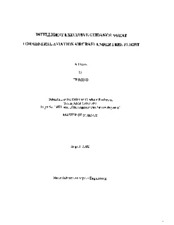| dc.creator | Rong, Jie | |
| dc.date.accessioned | 2012-06-07T23:18:04Z | |
| dc.date.available | 2012-06-07T23:18:04Z | |
| dc.date.created | 2002 | |
| dc.date.issued | 2002 | |
| dc.identifier.uri | https://hdl.handle.net/1969.1/ETD-TAMU-2002-THESIS-R66 | |
| dc.description | Due to the character of the original source materials and the nature of batch digitization, quality control issues may be present in this document. Please report any quality issues you encounter to digital@library.tamu.edu, referencing the URI of the item. | en |
| dc.description | Includes bibliographical references (leaves 105-106). | en |
| dc.description | Issued also on microfiche from Lange Micrographics. | en |
| dc.description.abstract | Conflict detection and resolution is a critical capability for the realization of free flight, a new concept of air traffic management that allows pilots to select their own flight paths and airspeeds in real time. A particularly demanding situation within this environment occurs when multiple traffic and weather conflicts arise simultaneously. A solution that forms the basis for this thesis is an agent based hierarchical system that attempts to provide optimal and conflict free flight path guidance in these multiple conflict situations. An intelligent executive guidance agent, acting as a high-level arbitrator, receives guidance information from a previously designed lower-level weather agent and a traffic detection and collision avoidance agent. When the flight path guidance from the two-lower level agents conflicts, the executive agent arbitrates by considering the spatial and temporal characteristics of the conflicting guidance. It classifies them as either tactical or strategic in nature, and then prioritizes them according to a pre-defined rule base of conflict priorities. The arbitration function thus acts as a fuzzy controller, and gradually switches the guidance between the weather agent and traffic agent, providing conflict free flight path guidance, as the aircraft flies in and out of dangerous regions. Results of test cases presented in the thesis demonstrate that the approach and algorithm can successfully resolve combined weather and traffic conflicts in real-time, subject to realistic imposed constraints. The severity of conflicting flight paths was managed within acceptable levels, and the ultimate recommended conflict free flight path is generally between those originally proposed by the weather and traffic agents. The algorithm does not exhibit any critical failures during cases tested, and proved robust and reliable. The proposed agent based hierarchical system, when integrated with a simplified flight management system coupled with a heading command and hold autopilot, offers an effective and reliable guidance and navigation system for generating safe, alternate flight paths in conflict situations. | en |
| dc.format.medium | electronic | en |
| dc.format.mimetype | application/pdf | |
| dc.language.iso | en_US | |
| dc.publisher | Texas A&M University | |
| dc.rights | This thesis was part of a retrospective digitization project authorized by the Texas A&M University Libraries in 2008. Copyright remains vested with the author(s). It is the user's responsibility to secure permission from the copyright holder(s) for re-use of the work beyond the provision of Fair Use. | en |
| dc.subject | aerospace engineering. | en |
| dc.subject | Major aerospace engineering. | en |
| dc.title | Intelligent executive guidance agent for general aviation aircraft under free flight | en |
| dc.type | Thesis | en |
| thesis.degree.discipline | aerospace engineering | en |
| thesis.degree.name | M.S. | en |
| thesis.degree.level | Masters | en |
| dc.type.genre | thesis | en |
| dc.type.material | text | en |
| dc.format.digitalOrigin | reformatted digital | en |


